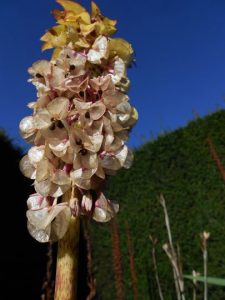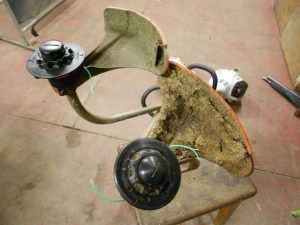Fruits abound this autumn, some less noticeable than others. Tucked away in the rock garden’s east valley is Euonymus nanus. As its name suggests this is a dwarf growing member of the genus. This low growing shrub is sparsely covered in linear leaves; the distinctively shaped and easily recognisable fruit capsule is bright red. The aril encasing the seed; orange.
Introduced by Reginald Farrer from Gansu Province, China where it is found in dry habitats in high mountain forest and scrub. Here it reaches 1m +, in cultivation on a rock shelf in the garden it barely makes 200mm.
South African bulbs did well this year; Eucomis bicolor is retaining its crown of leafy bracts topping off the flowered spike. This spike is now covered in paper thin angled seed pods. Held within are the small shiny black seeds. If fertile, sown into compost the resultant seedlings will give a flowering plant within five years.
As day length shortens and average temperature drops the need to cut grass reduces and then the relief of the last cut. This is the time to give mowers, strimmer’s and other equipment a seasonal clean. Wet grass is a congealing mass in corners of hoods and guards and on the blades of mowers and shears.
The attached image of a strimmer hood illustrates how lack of maintenance results in a build-up of layers of clippings. It is too easy to thrust a machine back into a shed at the end of the job. Yet a couple of minutes with a strategically placed stiff bristled hand brush and an old knife prolongs the life of the equipment and makes it easier to use the next time.
A light spray with duck oil prevents rust forming on metal parts.
Of course, if you treat equipment with respect and clean it after use it goes without saying the big clean at the end of the season will be minimal.



1 Comment
1 Pingback